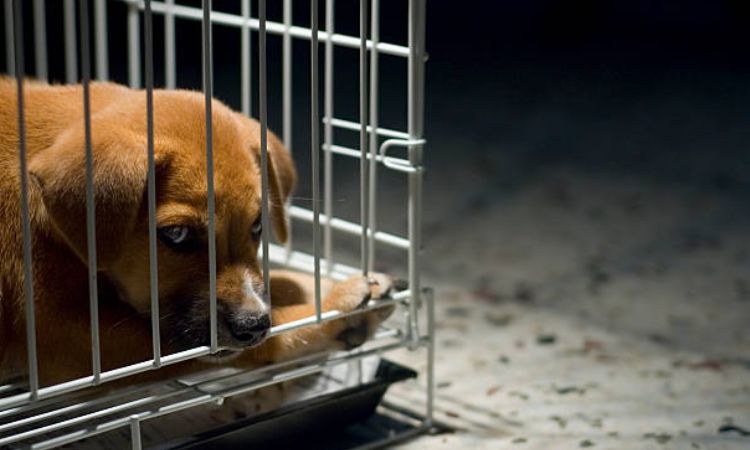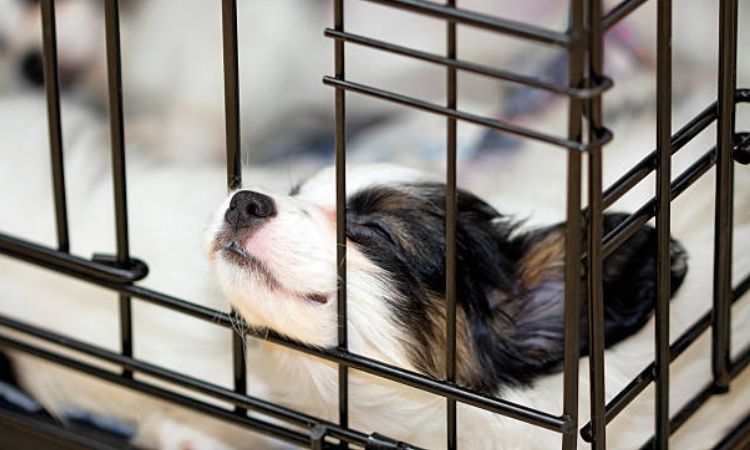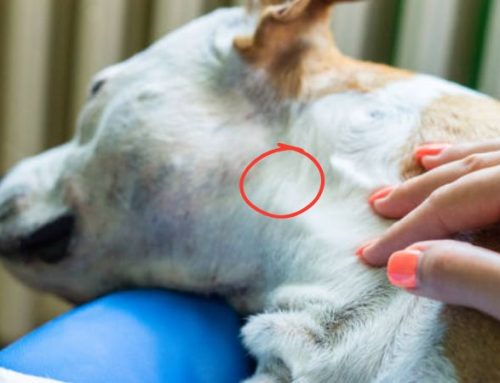Crate training a puppy doesn’t have to feel overwhelming, especially when the crate becomes a place your dog genuinely enjoys. When used the right way, it can turn chaotic nights into calm, predictable routines.
In this guide from Nexus Pets, we’ll walk you through five expert-approved steps to help your puppy settle comfortably at night so the crying stops, the stress fades, and everyone finally gets a full night’s sleep.
Why Puppies Cry in Their Crate at Night
It’s completely normal for puppies to cry in their crate at night, especially during the first few weeks after coming home. Puppies are naturally social animals, and being separated from their littermates, mother, and familiar environment can trigger anxiety and stress. For a young puppy, a crate can feel like a strange and restrictive space, which may lead to vocalizations as they try to cope with their new surroundings.
Several factors commonly contribute to nighttime crying:
- Separation anxiety: Puppies may feel lonely and insecure when left alone, especially if they are used to sleeping alongside their littermates.
- Discomfort or unfamiliar environment: The crate may feel confining or uncomfortable if it’s not properly cushioned or arranged with toys and blankets.
- Bathroom needs: Puppies have small bladders and limited control, so they may cry when they need to relieve themselves.
- Attention seeking: If family members are nearby, a puppy may cry to gain attention or interact with the household.
For pet owners, hearing your puppy cry throughout the night can be exhausting and frustrating. It’s natural to feel concerned or unsure of how to respond. Understanding the reasons behind the crying can help you approach crate training with patience and empathy, transforming nighttime routines into a positive and calming experience for both you and your puppy.
When addressing what to do when puppy cries in crate at night, it’s important to combine strategies like providing comfort, ensuring enough bathroom breaks, gradually increasing alone time, and creating a cozy, secure environment. By identifying the cause of the crying and responding thoughtfully, you can teach your puppy that the crate is a safe and comforting place to rest, even during the night.

How Long to Let Your Puppy Cry in the Crate at Night
For many new puppy owners, nighttime crate crying can feel overwhelming. Puppies, especially those under four months old, are adjusting to being away from their mother and littermates for the first time. It’s normal for them to vocalize their discomfort, whether it’s whining, barking, or howling. Understanding how long to let your puppy cry in the crate at night is essential for both their emotional well-being and your sanity.
Most experts agree that allowing a puppy to cry for short intervals—usually two to three minutes at a time—is acceptable. This gives them a chance to self-soothe without feeling abandoned. If the crying persists beyond a few minutes, it’s important to check whether your puppy needs a bathroom break, reassurance, or simply a calm presence nearby. Over time, puppies learn that the crate is a safe and comforting space, reducing the length and intensity of crying episodes.
Placement of the crate can make a significant difference. Keeping the crate in your bedroom or nearby allows the puppy to sense your presence while learning independence. Sitting quietly by the crate or softly speaking to them during the first few nights can reassure them without creating a habit of demanding attention through crying. Gradually, as your puppy becomes more confident, you can move the crate farther away or leave the room once they settle.
Other strategies to reduce nighttime crying include ensuring your puppy has had enough exercise, bathroom breaks, and mental stimulation before bedtime. Making the crate a positive and cozy environment with soft bedding, familiar toys, and calming pheromones can also help your puppy feel secure and reduce anxiety.
By following a consistent routine, being patient, and offering gentle guidance, you’ll find that your puppy begins to sleep more peacefully through the night. Understanding how long to let your puppy cry in the crate at night, paired with supportive training techniques, ensures a smooth transition for both puppy and pet parent.
5 Pro Steps for Effective Puppy Crate Training at Night
Crate training your puppy at night is one of the most important steps to help them feel secure, prevent accidents, and establish healthy sleep habits. While it can be challenging at first, following these five professional steps can make the process smoother, more predictable, and successful for both you and your puppy.
Step 1: Create a Comfortable Crate Environment

The first step in effective crate training is ensuring the crate feels like a safe and inviting den. Your puppy should view the crate as a comfortable space, not a punishment.
- Bedding: Provide a soft, washable bed or blanket that allows your puppy to stretch and rest comfortably. Consider age-appropriate beds for teething puppies that can withstand chewing.
- Toys and Chews: Place safe chew toys, a teething ring, or interactive puzzle toys in the crate to keep your puppy occupied and create positive associations.
- Placement: Situate the crate in a quiet but familiar area of the house. Ideally, it should allow your puppy to see family activity without feeling isolated. For young puppies, placing the crate in your bedroom or near your bed can provide reassurance and reduce nighttime anxiety.
Adding calming elements, like a dog-appeasing pheromone diffuser or soft background music, can further help your puppy feel safe and relaxed at night.
Step 2: Establish a Consistent Bedtime Routine

Routine is critical for nighttime crate training. Puppies thrive on predictability, and a structured schedule helps them understand when it’s time to sleep.
- Set a consistent bedtime: Try to put your puppy in their crate at the same time every night.
- Calm pre-bedtime activities: Avoid high-energy play before bedtime. Use this time for gentle petting, quiet bonding, or a short walk to the potty area.
- Signal crate time: Use a specific phrase, like “bedtime” or “crate time,” and consistently guide your puppy into the crate. This verbal cue helps them associate the crate with rest.
Over time, the repetition of a calming routine signals to your puppy that nighttime is for sleep, reducing anxiety and restlessness.
Step 3: Exercise and Potty Break Timing

A well-exercised puppy is more likely to settle quickly into their crate. Mental and physical stimulation during the day helps reduce excess energy that can lead to nighttime whining or crying.
- Daytime exercise: Engage your puppy in walks, interactive play, and safe indoor exercises. This not only expends energy but also helps socialize and stimulate your puppy’s mind.
- Evening potty break: Always take your puppy outside immediately before bed. This prevents nighttime accidents and reinforces the connection between the last trip outdoors and crate time.
- Food and water timing: Avoid large meals or excessive water close to bedtime to minimize late-night potty needs. Puppies generally cannot hold their bladder for long periods, so timing meals and breaks carefully reduces interruptions and supports successful crate training.
Step 4: Respond Calmly to Crying

It’s normal for puppies to cry, whine, or bark when first adjusting to their crate. How you respond can shape your puppy’s understanding and comfort level.
- Short waiting periods: Allow your puppy a few minutes to self-soothe, as this teaches patience and independence.
- Gentle reassurance: If crying escalates, calmly enter the room, speak softly, or place a hand through the crate bars. Avoid yelling or giving excessive attention, which can reinforce anxious behavior.
- Consistency is key: Decide whether to ignore minor crying or provide minimal reassurance, and stick to that approach. Mixed signals can confuse your puppy and prolong anxiety.
Over time, a calm and predictable response helps your puppy learn that the crate is safe and comforting, not a source of stress.
Step 5: Gradually Increase Crate Time to Build Confidence

Nighttime crate training is most effective when done progressively. Gradually increasing crate time allows your puppy to gain confidence and develop independence.
- Start with short periods: Begin with short, supervised crate sessions during the day before extending to nighttime.
- Incremental increases: Slowly extend the duration of crate time, both day and night, as your puppy becomes more comfortable.
- Positive reinforcement: Reward calm behavior with treats, praise, or a favorite toy. Avoid letting your puppy out of the crate while they are frantic or crying, as this may reinforce negative behaviors.
By steadily building your puppy’s comfort and confidence, the crate becomes a secure, enjoyable space rather than a source of stress.
Additional Tips to Stop Crying and Ensure Full Night’s Sleep
Helping your puppy settle into a full night’s sleep often requires more than just a comfortable crate and consistent routine. Supplemental strategies and thoughtful reinforcement can make nighttime crate training easier, more effective, and less stressful for both you and your puppy.
Use Calming Tools and Environmental Aids
Creating a soothing environment in and around the crate can reduce anxiety and encourage longer periods of uninterrupted sleep:
- White noise: Playing gentle white noise or soft music can help mask household sounds and create a consistent auditory environment, which reassures your puppy and prevents sudden noises from startling them awake.
- Crate cover: Partially covering the crate with a lightweight blanket can create a den-like atmosphere, reducing visual distractions and signaling a safe, cozy space for rest. Ensure proper airflow so your puppy stays comfortable.
- Temperature and lighting: Keep the sleeping area at a comfortable temperature—neither too hot nor too cold—and avoid bright lights that can interfere with your puppy’s circadian rhythm.
These environmental adjustments signal safety and calmness, helping your puppy relax and sleep more soundly through the night.
Avoid Late Feedings and Excess Water Before Bed
Late-night meals or unrestricted water access can lead to nighttime potty needs, which disrupt sleep and may cause crying in the crate. To prevent this:
- Offer the final meal of the day a few hours before bedtime.
- Limit water intake right before sleep, while ensuring your puppy stays hydrated throughout the day.
- Maintain a consistent feeding schedule so your puppy learns when to expect meals, which helps regulate energy levels and bathroom habits.
This approach reduces the chance of nighttime accidents and supports the establishment of a predictable bedtime routine.
Use Positive Reinforcement Consistently
Positive reinforcement is key to helping your puppy associate the crate with comfort, security, and rewards:
- Praise calm behavior with gentle verbal cues or light petting.
- Reward your puppy with small treats for voluntarily entering the crate or remaining quiet during the night.
- Avoid rewarding crying, barking, or whining with attention, as this can inadvertently reinforce anxious behavior.
Gradually, your puppy will learn that calm, quiet behavior in the crate leads to positive outcomes, increasing their willingness to stay in the crate peacefully.
Encourage Gradual Progression
Every puppy adjusts at a different pace, so gradual training is essential:
- Start with shorter nighttime crate sessions and gradually extend the duration as your puppy becomes more comfortable.
- Be patient if your puppy cries initially; minor setbacks are normal.
- Slowly reduce your presence or interventions, allowing your puppy to self-soothe and gain confidence in the crate.
By progressing step by step, your puppy develops independence and resilience, ultimately learning to sleep through the night without stress.
Dog owners might be interested:
- How to toilet train a puppy in 7 days
- How to potty train a dog in 3 days
- Puppy toilet training at night
Supplemental strategies like white noise, crate covers, and proper scheduling, combined with consistent positive reinforcement and gradual training, can dramatically reduce nighttime crying. With patience and consistency, your puppy will not only sleep better but also feel secure and confident, setting the stage for lifelong healthy sleep habits and a strong bond with you.






